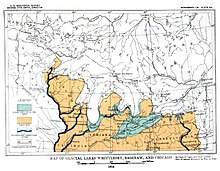
Lake Whittlesey was a proglacial lake that was an ancestor of present-day Lake Erie. It formed about 14,000 years ago. As the Erie Lobe of the Wisconsin Glacier retreated at the end of the last ice age, it left melt-water in a previously-existing depression area that was the valley of an eastward-flowing river known as the Erigan River that probably emptied into the Atlantic Ocean following the route of today's Saint Lawrence River. The lake stood at 735 feet (224 m) to 740 feet (230 m) above sea level. The remanent beach is not horizontal as there is a ‘hinge line’ southwest of a line from Ashtabula, Ohio, through the middle part of Lake St. Clair. The hinge line is where the horizontal beaches of the lake have been warped upwards towards the north by the isostatic rebound as the weight of the ice sheet was removed from the land. The rise is 60 feet (18 m) north into Michigan and the Ubly outlet. The current altitude of the outlet is 800 feet (240 m) above sea level. Where the outlet entered the Second Lake Saginaw at Cass City the elevation is 740 feet (230 m) above sea level.[1] The Lake Whittlesey beach called the Belmore Beach and is a gravel ridge 10 feet (3.0 m) to 15 feet (4.6 m) high and one-eighth mile (18 meters) wide. Lake Whittlesey was maintained at the level of the Ubly outlet only until the ice melted back on the "Thumb" far enough to open a lower outlet. This ice recession went far enough to allow the lake to drop about 20 feet (6.1 m) below the lowest of the Arkona beaches to Lake Warren levels.[1]
The strip of Lake bottom between the Whittlesey and Warren beaches in southeastern Michigan is largely a clayey plain, the principal exceptions being at deltas of Lake Arkona. The deltas of streams entering Lake Whittlesey are less conspicuous than of the same streams in connection with its predecessor, Lake Arkona. One reason for this is the fact that the rise of water caused estuarine conditions for some distance up the valleys beyond the Whittlesey beach, and it was necessary to fill these estuaries from their heads down-stream past the beach before the lake-bed proper would receive a coating of delta material.[1] Frank Taylor named this body of water, Lake Whittlesey in 1897, in honour of Charles Whittlesey.[2] The lake created the Belmore beach of the Erie-Huron basin. It flowed across the "thumb" of Michigan, through an outlet known as the Ubly outlet.[3]
- ^ a b c Publication 9. Geological Series 7; Surface Geology and Agricultural Conditions of the Southern Peninsula of Michigan; Frank Leverett with a Chapter on Climate by C. F. Schneider;Michigan Geological and Biological Survey Lansing Michigan; 1911
- ^ "The Pleistocene Geology of the Fostoria Quadrangle". 1942. CiteSeerX 10.1.1.629.7638.
- ^ Chapter XV.; The Glacial Lake Whittlesey; Frank Taylor; Glacial Formations and Drainage Features Erie and Ohio Basins; Chapter XV, The Glacial Lake Whittlesey; Frank Leverett; Government Printing Office; Washington, D.C.; 1902; pg 741-757
